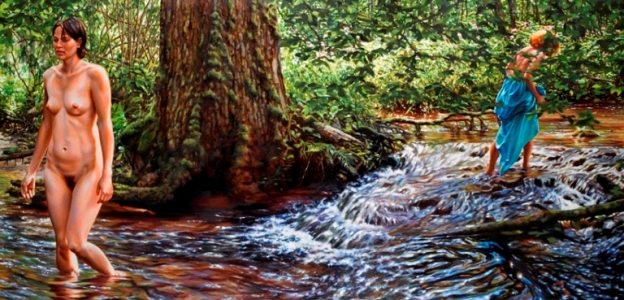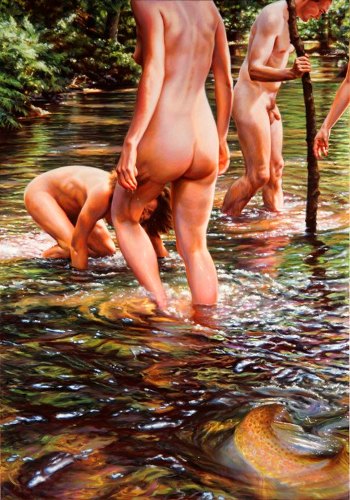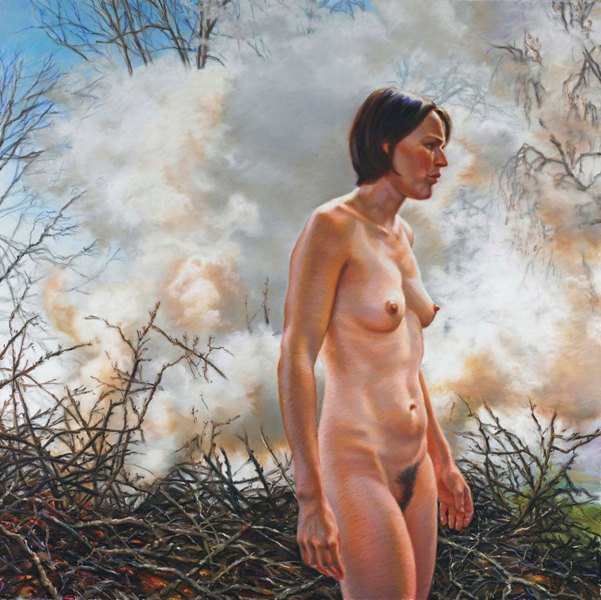David Herrle interviews Susannah Martin, painter
I discovered the splendid work of Susannah Martin in Juxtapoz magazine (which recently named her one of the best artists of 2013) and was immediately drawn to her handling of nudes. There was something different about them. The subjects (male, female, adults, children) were liberated, apparently unposed, volitional. As someone who’s a sucker for reclining nudes and Ingres-type dehanchement, I was pleasantly jarred – and became an instant fan. No wonder the Huffington Post included Susannah’s Gorge in its 10 Memorable Paintings of 2013. What follows is one of my favorite interviews with an artist.
David: You worked as a professional set and mural painter for almost 30 years. The examples of your work are vivid and remarkable. How did this career come about, and what kept you in it for so long?
SM: Well, it was closer to 20 years but still, that is a very long time. My family was quite poor, with my father deceased and there being five children. I began working after school I think at about the age of 10. I worked throughout high school and college to make tuition. Some jobs were of little importance but others brought me great practical experience: assisting artists, architects, restoring paintings, printing workshops, etc. During my last year of study at New York University, where I was a fine-arts major, I began to work for Sandro La Ferla Backdrops Inc. Sandro is from Torino, Italy and had made a name for himself in New York City as a set designer for the Opera. He is also an exceptional painter and enjoyed painting the backdrops himself, so he started a business painting backdrops and renting them out at a daily rate to photographers and film companies, primarily for advertising. There was a stock of over 400 backdrops, huge canvases, and he had a fine business going for many years until Photoshop came into being. I learned about set-painting techniques by watching him. In 1990 I went independent, painting backdrops and murals in New York and Germany. I kept doing it for so long because the money is fairly good and reliable but also because I loved it. I am still completely fascinated by large-scale painting, but I became unhappy with never really being able to realize my ideas. It is very rare that a mural client gives you complete freedom, and the set painting is often only used for a short time and then thrown away. I reached a point where I had to do my own work again, for richer or poorer.
David: After being born and raised in New York City, your first major relocation was to Berlin, Germany, and you now live now live in Frankfurt am Main. Why Germany? Has your maturation in the metropolis of metropolises and your emigration to one of the largest European cities informed your attraction to and respect for the rural and nudism in art?
SM: I was born in New York City and returned for 10 years later, but I grew up in New Jersey, so I did have some experience with the rural environment. My early experiences with nature as a child where very intense and personal, as they are for most children. My happiest moments, in fact, were spent playing alone in a park near our house, on the beach or at the river bank. There is a time in childhood when trees and plants and small animals feel like real friends. I have to work harder to get to that place now, but it is still there. I am happiest in nature. Why Germany? I first visited Europe when I was 14. I knew immediately that I wanted to move to Europe as soon as I could find a way to do it. Germany is the greatest cultural hub in Europe and the most interesting to me as far as the developments in the visual arts are concerned. I wanted desperately to study in Düsseldorf with Gerhard Richter when he was professor there, but I couldn’t make it work financially.
David: Philip Pearlstein’s name comes to my mind instantly when considering your work, but I consider you anti-Pearlstein. His somnolent nudes are placed in claustrophobic interior spaces; sometimes bodies overlap each other. Your nudes aren’t listless or cloistered by walls. They’re free to explore airy panoramas (and are a far cry from art tradition’s reclined and idle odalisques). Yet, has Pearlstein’s work ever been a conscious factor in your work? Please spiel about your favorite artists, confinement versus open air, and posed subjects versus active ones.
SM: I’m glad to hear that you feel I have moved far from the traditional odalisque. That is very important to me. Philip Pearlstein certainly was an artist with whom I was familiar from an early age. My mother is also a figurative painter, and I remember looking through reproductions of his work as a kid. Pearlstein and the photorealists were heroes in a way when they started to show up on the art scene in the Seventies. Well, they were heroes to all the figurative painters because the figure had been completely banned from the Avant-garde. It was Pop Art which opened the door for the figure to come back after a long phase of exclusively minimal and abstract painting. Realists like Pearlstein, Alfred Leslie, Chuck Close, or my teacher John Kacere, brought a new, bold, hyper-real vision of the figure to contemporary art. They rescued realistic figure painting from the dusty, moldy salon image of the 19th century which the 20th century wanted nothing more to do with! The fact that this new realistic figure painting embraced its relationship with photography was the key to re-enter the Avant-garde.
My painting clearly owes a great deal to the influence of the photorealists. But I also have to mention some of the early Dutch and German early-renaissance masters like Van Eyck, Van der Weyden, Memling and Holbein, who were so obsessive in their exactitude that they could be considered the photorealists of the 15th century. This period of northern European painting has always been my most treasured and admired. As far as confinement and posing is concerned, that is what I have most wanted to get away from. That always bothered me, that fakeness. People don´t go about their day constantly striking poses, for the most part. I view my models and landscapes first through the camera before I begin to paint so it is possible to paint people in natural and random movement. The camera has given us this great opportunity and as a modern painter it feels most natural to me to take advantage of it.
David: In “Primordial Tourists,” you decry humanity’s alienation from nature and write: “How absurd man seems stripped of his possessions and identity crutches.” I add that man’s body loses its specialness and sexual radiation in harsh nature: filthiness, insect bites, blisters, infections ensue. I thank art for rescuing the nude from blemish and degradation. You present clean, sensual, attractive bodies. “Tourists” continues: “[Y]et [Man] gains strength, clarity and beauty when we contemplate him abstractly, as a phenomenon of nature.” Elaborate on your attempted resolution between the nude and the landscape, the glory of abstraction, the curious concept of “primordial tourists.”
SM: If it is true that man loses his sexual radiation in a natural environment, than I suppose that would give him a strong motivation to want to be rid of the bugs and plants that bite and cause rashes. But isn’t that an outrageously arrogant position toward nature, that our vanity alone justifies the extermination of thousands of species of plants and animals? Outrageous, and unfortunately true. We will destroy everything in our path to maintain our lofty position and satisfy our vanity and greed. One of my first intentions with these nudes was to break through the artifice of the traditional form of the painted nude in landscape. I want them to feel more like records of man’s real interaction with nature than his fantasy of that experience. In that point I agree with you that I have not yet included enough bug bites and blood, although you will notice that my fair-skinned model in Gorge is indeed a bit scratched up on her belly, from rock climbing. I will have to go much further with that if I want to turn away from the business of “rescuing the nude from blemish and degradation,” which of course is the traditional role of the nude: to create a blemish free, sexually radiant object for our visual consumption. That is exactly what I would like to do, to push the nude toward a new, non-consumption oriented purpose, toward being a catalyst for self-reflection.
David: I agree with you that “nature does not possess an identity, it is.” But I wonder about your claim that humanity’s true home is “independent of identity in a time of pure being.” Along with agreeing with William Blake that nature is barren without man, I place humans’ beingness in identity and think it’s incumbent on us to transcend mere isness. In his famous “Ten O’Clock” lecture (1885), James Whistler said that “to say to the painter that Nature is to be taken as she is, is to say to the player that he may sit on the piano.” What is “pure being?” Would we be better off existing anonymously in it?
SM: I do not know if nature would be barren without man. For us of course that is true, but I tend to believe that nature would thrive far better without us. What I do know, is that man would be barren without nature. Man has no chance of surviving outside of the ecosystem in which we live. For me transcendence moves in the opposite direction: we must ultimately learn to let go of the idea of separate identity, or ego, and find ourselves as part of the one whole. “Pure being” is for me this infinite power of creation of which we are all part. By “we” I mean all physical manifestations of the infinite power of creation, plant, animal, human. Some people refer to this ultimate home as the spirit. I am always reluctant to talk about spirituality as it often meets with hostility in our contemporary society which is trying hard to rid itself completely of the concept of the spirit.
Peter Sloterdijk, the contemporary German philosopher, pointed out very accurately in his book Du musst dein Leben ändern that “vorauseilende Entgeisterung ist seit Jahrzehnten der Zeitgeist selbst” (translated as best as I can: “for decades already, run-away de-spiritualization is the spirit of the times itself”). Whether we believe that we are living in a post-spiritual time or not, we all have firm roots in belief systems. Before Judaism and subsequent Christianity, many forms of religious beliefs embraced the idea that the natural world also possessed spirit. Judaism and Christianity introduced the idea that only man is created in God’s image and only man was given a divine soul. The rest of nature was simply created by God for man to make use of. Most contemporary Western societies follow this Judeo-Christian belief system, even if they do not consider themselves Jewish or Christian. However, many eastern religions still embrace the idea that there is one spirit of which we are all part: plant, animal, human. The idea that all life arises from the same source of energy, and returns to it, is also supported by contemporary quantum-physics theories. Our attitude toward nature and ecology depends a great deal on which position we take regarding the spirit, or in which tradition of thought we are anchored.
David: I can’t help but notice your unapologetic inclusion of female pubic hair. This is heartening, since the boring trend of bald pudenda has persisted for at least the last 25 years. (Despite my praise of artifice and mown flora, I applaud the tufts in Courbet’s Origin of the World, in any Delvaux or Magritte nude.) What are your thoughts on the evident dearth of the “bush” in fashion, photography, even pornography? Also, do you paint from live models?
SM: Essentially, the denial of the biological fact of body hair is just part of a much larger system of denial. It’s all part of the same illusion that we are not part of nature. The present deforestation of the human body originated in pornography. The fact that it has become mainstream just reflects the fact that porn has become mainstream. Porn has become accessible to anyone, anytime through the Internet and has become one of the largest profit-making industries that exist, and this industry is now controlling our sexual imagination. Life is imitating fiction, the tail is wagging the dog. So yes, I am aware that the occasional inclusion of pubic hair is a political statement, my little way of fighting the powers that be. Probably the strongest motivating conviction behind my work is that reality is infinitely more fascinating and complex than any marketing genius creating fantasies would like us to believe and buy.
David: You work as a portraitist these days. This must be a heavy responsibility: rendering a client’s image in both a flattering and honest manner. Tell us about this profession, how it strikes you and what it involves.
SM: In general, I am working less and less as a portraitist, but I am, in fact, painting one at the moment. It is a very, very difficult job. Artists are invested in creating an interesting piece of art, not necessarily in flattery. I do feel that I always make my subjects attractive, not because I am trying to flatter but because I legitimately see the people as beautiful. The problem is that most people don´t feel beautiful themselves. Probably because we live in a culture which constantly tells us that we must use our appearance for its market value. We are also constantly being told that our appearance should be improved, which will increase our value. In other words, we are being told that we are not OK the way we are in order to sell us a constantly expanding array of products and procedures. Of course, everyone wants to be attractive, especially for sexual advantages, that has always been the case, but I do believe that we have gotten to a very unhealthy level of insecurity. The problem with making the portrait client happy is that it is virtually impossible to read their minds and recreate the fantasy that they have of what they should look like. That is the only reason why I shy away from portraits, although there is nothing that I love to paint more than the human face.
David: Susannah, I’m pleased that I discovered your lovely, important art. Do you have any closing words for our readers?
SM: Thank you very much David. It was my pleasure to talk with you, and thank you, readers, for your interest in my words and works.
Visit Susannah’s official website here.
View some of her work here.



